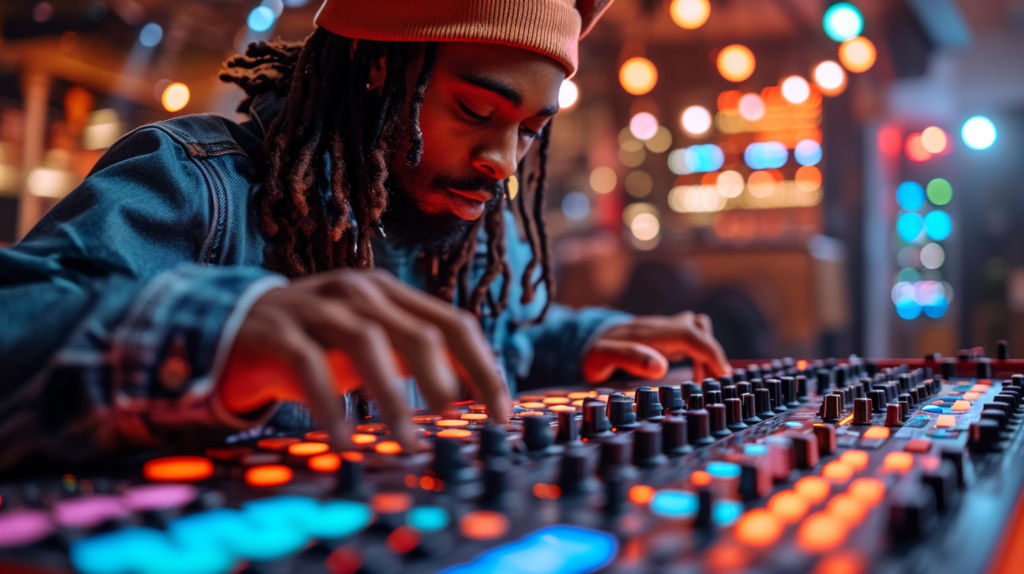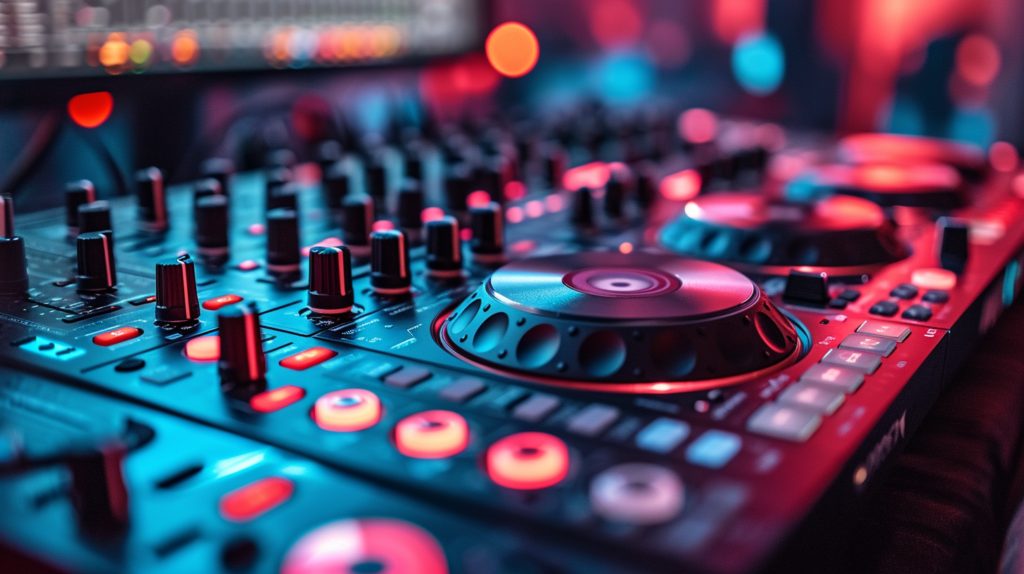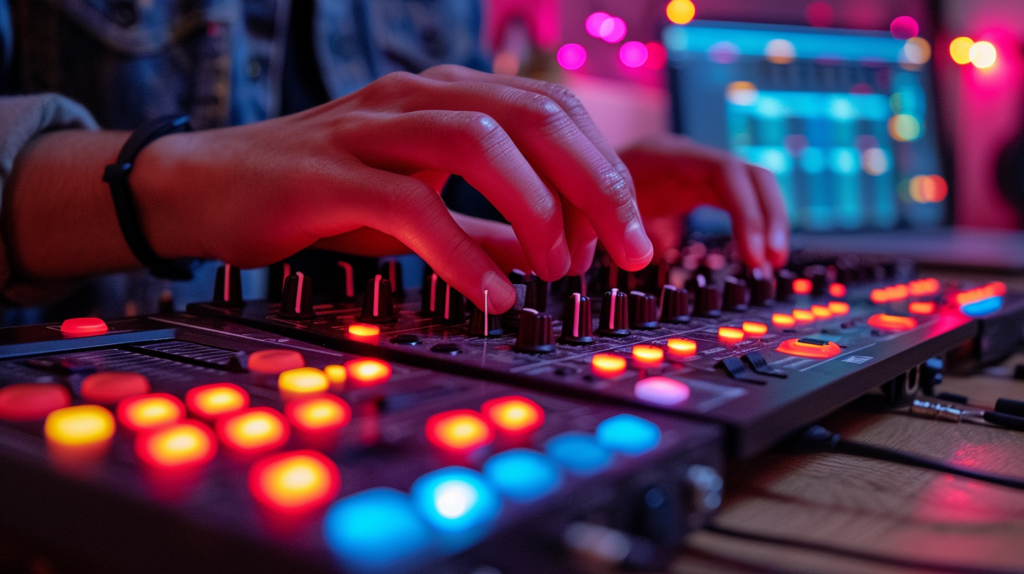Have you ever seen a DJ effortlessly trigger sounds, drums, and loops from their controller and wondered if you could make your own tracks the same way?
Well, the good news is that today’s advanced DJ controllers and music software provide all the tools necessary for crafting studio-quality beats without requiring any external gear or instruments. Any creative ideas can be quickly brought to life through real-time drum pad performance and intuitive tweaking of synths and effects.
Let’s explore how this unique, controller-driven beatmaking process works from start to finish so you can begin producing too!
Can You Produce Beats With a DJ Controller?

Yes, absolutely. The latest controllers provide velocity-sensitive, RGB backlit performance pads for drum programming, transport controls for easy clip sequencing, assignable knobs/faders for sound tweaking, and tight software integration for manipulating synths and effects. This gives an immediate, hands-on production environment without requiring any external instruments, keyboards or gear. While the learning curve varies, the creative flexibility makes controllers well worth exploring for beatmaking. Let’s examine exactly how the production process works.
What is a DJ Controller?

A DJ controller is a hardware device that allows DJs to control DJ software. It has jog wheels, faders, knobs, pads, and buttons that can be used to manipulate music playing through DJ software on a computer. The controller connects to the computer running the software either via a USB cable or wirelessly. This allows the DJ to have a tactile, hands-on experience when mixing tracks rather than only using a computer mouse and keyboard.
DJ controllers provide a range of benefits for music production purposes beyond DJing. For example, the pads and buttons allow beat production by allowing drum sounds to be assigned and sequenced. The faders and knobs also enable intuitive manipulation of sounds within music production software. Most controllers have a built-in audio interface which means producers can monitor the audio output directly without latency issues. Finally, DJ controllers add a great deal of portability to music production setups – producers can take their controller and laptop anywhere and work on tracks on the move.
Benefits of Using a Controller to Make Beats

Using a DJ controller to make beats and produce music provides a much more tactile and performative experience compared to only utilizing a mouse and keyboard with a computer and software. The hands-on workflow enables easier drum programming and manipulation of sounds. DJ controllers designed for music production usually come equipped with velocity-sensitive RGB backlit pads which light up and allow drum beats to be input in a manner similar to playing drums or finger drumming.
Sequences and patterns can then be built up from the recorded drum hits. Controls like assignable knobs and faders make tweaking parameters such as filters, effects, and volumes an intuitive process, allowing producers to focus on the musicality rather than technical aspects. Most controllers connect via a USB audio interface which provides low-latency monitoring of sounds as they’re being created, leading to a better creative flow. The portability aspect should also not be overlooked – with just a controller and laptop, music can be made anywhere inspiration strikes!
Essential Features in a Production Controller

For harnessing the benefits outlined above and effectively producing full tracks using DJ software, there are some essential features to look out for when selecting a DJ controller for beatmaking:
RGB Backlit Pads
Velocity-sensitive RGB backlit performance pads are arguably the most important controller feature for beat production purposes. The pads allow sounds (usually drum hits) to be assigned to them so beats can be input in real-time by playing the pads, akin to playing drums or a percussion instrument. The velocity sensitivity enables drum sounds to respond dynamically based on how hard the pads are hit, making the process more like playing actual drums.
The RGB lighting provides visual feedback on parameters like which sounds are assigned or if the pads are activated for recording. Overall, backlit pads transform a controller into an instrument for inputting rhythms and beats rather than just something to mix with.
Assignable Faders and Knobs
While software instruments and effects can be controlled well enough with a mouse, physical faders, knobs, and other controls make the process of manipulating sounds much more intuitive. Controllers aimed at music production provide assignable controls that can be mapped to various software parameters so elements like filters, effects, volumes, and more can be tweaked in real-time for better creative flow.
Transport and Navigation Controls
Transport controls for starting, stopping, and recording sequences are essential, as well as navigation controls to skip through project sections or patterns without needing to use the computer’s mouse or keyboard. These controls help maintain focus on the controller unit while laying down musical ideas.
Mixer with EQs and Filters
An integrated mixer with EQs, filters, and channel faders provide similar benefits to the assignable controls but specifically tailored to smooth mixing of tracks. Having these mixer elements directly on the controller rather than only in software helps keep music production projects cleanly organized.
Sequencer Buttons
Many controllers have buttons specifically to activate the software’s sequencing functions to record beat programming in real-time as well as transport controls. Having quick access to sequencer controls right on the controller’s interface aids efficient music production workflow.
DJ Software for Beat Production

While DJ controllers themselves provide excellent hands-on control for manipulating sounds, they still need accompanying DJ software on a computer to access instruments, effects, and project arrangement functionality. Some top options DJs use for beat production include:
Native Instruments’ Maschine
Arguably the most popular software designed specifically for music production via controller hardware, Maschine integrates perfectly with Native Instruments’ range of controllers. The software has a range of drum synths and instruments, effects, and sequencing functionality tailored to beat-making workflows. The controller hardware also has a range of buttons and controls directly aimed at manipulating Maschine’s features.
Ableton Live
Ableton Live is a widely used DAW for a range of music production tasks and famously has a uniquely flexible approach to clip-based sequencing that is conducive to performance and playing instruments like controllers live. DJ controllers can be mapped to access Live’s session view controls for playing clip-based ideas fluidly.
Image-Line FL Studio
FL Studio has some uniquely comprehensive sequencing, pattern programming, and drum programming capabilities. Using a controller gives an intuitive way to access these tools compared to only using a mouse and computer keyboard. Many DJ controllers have templates available for controlling FL Studio’s functions.
Serato Studio
Specifically designed by DJ hardware/software company Serato for integration with their official controllers. Serato Studio aims to bridge the gap between DJ and producer workflows, making it simple to trigger samples, loops, and sequences to build tracks. It’s an all-in-one option similar to Native Instruments’ Maschine.
The above software options combined with comprehensive production-focused controllers transform a DJ setup into a versatile beat making rig without needing multiple pieces of hardware.
Making a Simple Beat from Start to Finish

To demonstrate a straightforward workflow for making a basic beat from scratch using a typical DJ controller production setup, follow these steps:
Laying Down Drum Sounds on Pads
After loading up a software instrument like Maschine or FL Studio and browsing sounds, various one-shot drum samples can be assigned directly to the controller’s velocity-sensitive RGB pads. Kicks, snares, hi-hats, percussion and any other desired drum sounds can be assigned and played freely like a drum kit. Different instruments or sounds can be loaded to other pad groups for playing melodic parts later if desired.
Recording and Sequencing Drum Patterns
Once assigned, playing the pads can then be recorded into a sequencer in real-time at a set BPM. Recording is activated via the controller’s sequencer buttons and transport controls rather than needing to use the computer’s mouse and keyboard. After capturing various drum patterns that way, the best parts can be kept, edited, copied/pasted in the software as desired to build up longer arrangements. The controller’s various buttons help navigate clips in the sequencer without disrupting creative flow by needing to use the computer.
Adding Basslines, Melodies, etc.
After the foundations of multiple drum patterns are laid out, the project can be expanded through adding complementary instruments and sounds. Software synths tailored to bass, leads, pads etc combined with the controller’s keys, pads provide creative options for inputting basslines, chord progressions and melodies to accompany the drum patterns to build a complete instrumental idea. The project continues to be driven primarily from the controller rather than computer keyboard and mouse.
Mixing and Arranging Parts into Song Structure
Finally when various patterns for verse, chorus, breakdowns etc have been recorded and sequenced, the software can be used to piece them together into an intelligible song structure and mix the various tracks together. The controller’s integrated mixing surface and assignable controls aid this process through having immediate access to EQs, filters, effects sends and volumes for each track in the project. After some careful mixing and arranging to create contrasts between sections, a complete and well-produced beat will emerge without ever needing a traditional MIDI keyboard workstation setup.
DJ controllers enable beatmaking and music production via an intuitive hands-on workflow. Combined with the right software, the entire process from sound programming to arrangement can largely be kept directly in the controller interface rather than constant mouse/keyboard computer operation. Through some practice, DJ controller and software combinations provide affordable yet surprisingly fully featured rigs for crafting professional sounding tracks through a uniquely performance-focused creative process.
Conclusion
In conclusion, DJ controllers provide an intuitive and affordable way to craft professional-sounding beats without needing an expensive music production setup. The tactile controls and tight integration with beatmaking software enables hands-on drum sequencing and sound manipulation that simply isn’t possible with a mouse and keyboard. While a learning curve exists, the creative benefits and portability options make DJ controllers well worth exploring for aspiring producers looking to ditch traditional workstations.
